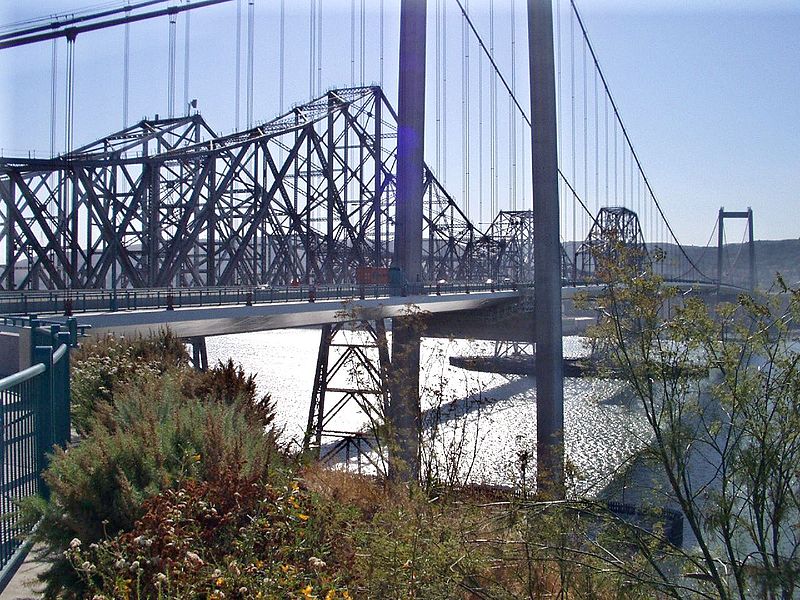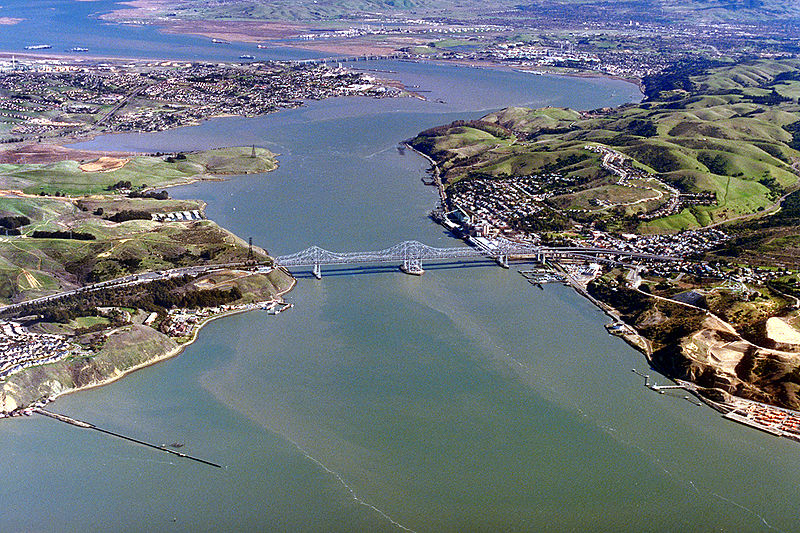| |||||||
Europe
North AmericaSouth AmericaAsiaAustralia and OceaniaAfrica |
Смотрите также: Carquinez Bridge The Carquinez Bridge refers to two parallel bridges which cross the Carquinez Strait linking Vallejo, California to the north, with Crockett, California to the south. The bridges are signed as part of Interstate 80. Toll is only charged to eastbound traffic.
Carquinez Bridge Official name Alfred Zampa Memorial Bridge (suspension bridge) Carries 8 lanes of I-80, pedestrians and bicycles Crosses Carquinez Strait Locale Crockett, California and Vallejo, California Design 2 Cantilever bridges and 1 Suspension bridge Total length 0.66 miles (3465 feet / 1056.1 m / 1.06 km) Clearance below 45 meters (148 ft) Opening date May 21, 1927 (original span) 1958 (eastbound) November 11, 2003 (westbound) Destruction date 2006 (original span) History and description The original bridge, a steel cantilever bridge, was designed by Robinson & Steinman and dedicated on May 21, 1927. It cost $8 million to build and was the first major bridge in the San Francisco Bay Area.
Upon completion of the 1927 bridge, the Lincoln Highway was rerouted over the span. The Lincoln Highway was the first road across America. Its original alignment from Sacramento to San Francisco avoided the un-bridged waterways of the San Francisco Bay and the Sacramento Delta by routing itself through the Altamont Pass and the central valley. With the bridge built, the Sacramento to San Francisco route was realigned in 1928 to pass along the eastern shores of the San Francisco Bay and San Pablo Bay, then in a northeastern direction. In 1958, a similar parallel bridge was built alongside the original one to accommodate the ever-increasing traffic. The original 1927 span served westbound traffic while the newer 1958 span served eastbound traffic. In 2003, as a resolution to seismic problems of the aging 1927 span, a new suspension bridge was opened to replace it. This new bridge was named the Alfred Zampa Memorial Bridge, after an ironworker who worked on a number of the San Francisco Bay Area bridges, including the Golden Gate Bridge. This span features a pedestrian and bicycle path, completing a bike trail which circles the entire Bay Area. The span measures 0.66 miles (3465 feet / 1056.1 m / 1.06 km). The bridge was dedicated on November 8, 2003 and opened for traffic on November 11. (Originally, the plan was to dedicate the bridge on November 15, but complications involving when just-recalled Governor Gray Davis would have to transfer power to Arnold Schwarzenegger resulted in the date being moved. The coins minted to commemorate the event have the old date on them.) It is the newest suspension bridge built in the United States, as of 2003. The 1927 span was dismantled in 2007, after it was temporarily used to hold eastbound traffic while the eastbound span underwent a seismic retrofit, deck and superstructure rehabilitation, and painting to extend its serviceable life. During demolition, the 3,000-pound bronze bell atop one of the Carquinez Bridge piers was removed and placed into storage. The bell will eventually be displayed in a new museum to be built at the Oakland end of the San Francisco – Oakland Bay Bridge.
Foundations The new Carquinez Bridge is a suspension bridge with spans of 147 m, 728 m, and 181 m. It consists of the south anchorage, a transition pier, two towers (South and North towers), and the north anchorage. The towers are each founded on two footings, which are each supported by six vertical, 3-m-diameter steel shells infilled with reinforced concrete, followed by 2.7-m-diameter drilled shafts in rock (i.e., cast-in-drilled hole, or CIDH, piles). The total length of the CIDH pile at the South Tower is approximately 89 m, with about 43 m of drilled shaft in rock. The total length of the CIDH pile at the North Tower ranges from 49 to 64 m, with about 16 to 26 m of drilled shaft in rock. The design parameters used for the South Tower piles were later confirmed by a pile load test. Additional field investigations during construction revealed significant variations in rock conditions at the North Tower, resulting in the redesign of the length of the piles. Major construction challenges encountered during construction of the South Tower piles, and the revised construction procedure used by the constructor to mitigate caving. By September 4, 2007, all of the original 1927 steel structure had been demolished. Comments: 0 |
|
|||||









































